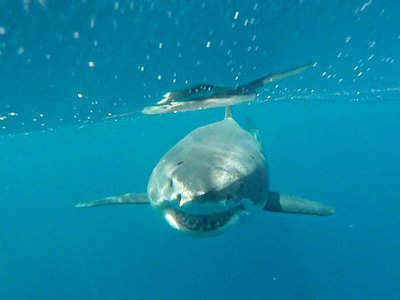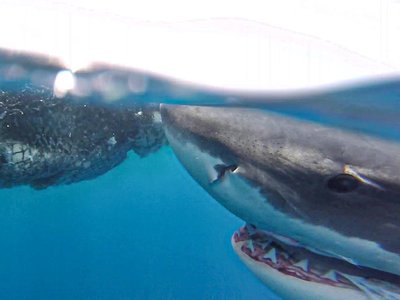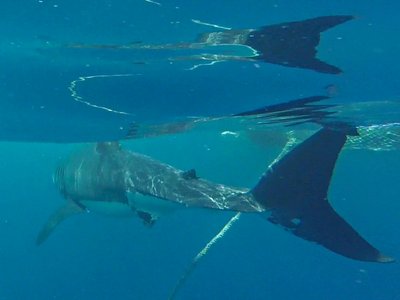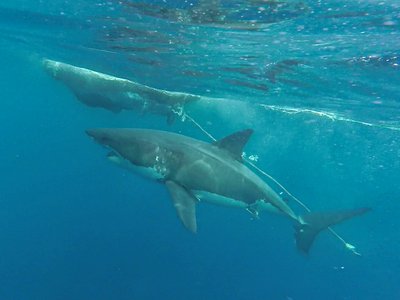Historic Sighting of White shark Recorded for the First Time in Ecuadorian Waters
Puerto Ayora, Galapagos, November 7, 2024 – Researchers from the Charles Darwin Foundation and the Galapagos National Park have published the first confirmed record of a white shark (Carcharodon carcharias) in Ecuadorian waters. The encounter, roughly ninety kilometers west of Wolf Island and outside the Galapagos Marine Reserve (GMR), marks an unusual sighting of this species in the Eastern Tropical Pacific, where sightings south of Mexico's coastline are exceptionally rare. The study was published in the journal Environmental Biology of Fishes.
The sighting took place on November 3, 2021, when crew member and co-author of the study Sergio Zanchi observed an adult female white shark, approximately 4 to 4.5 meters in length, circling a Fish Aggregating Device (FAD) on board the industrial tuna vessel Connie Jean Two. The presence of this species in the area during the cold season is believed to be related to the unique oceanographic conditions resulting from the La Niña event in 2021, which may have facilitated this individual’s migration to Ecuadorian waters. La Niña is an extreme natural climate event characterized by unusually cold waters in the Eastern Pacific compared to years when the event does not occur.

Pelayo Salinas-de-León, lead author of the study and co-PI of the Charles Darwin Foundation’s shark ecology project, notes: “This study underscores the vital role of citizen science in marine research. Thanks to Sergio Zanchi, we were able to confirm, without doubt, the presence of a white shark in Ecuadorian waters. The temporary visit of one of the ocean's most formidable animals—and a species essential to marine ecosystem health—is yet another reason to celebrate Ecuador’s biodiversity.”
The white shark, also known as the great white shark, commonly inhabits cold or temperate waters, such as those off South Africa, Australia, the Pacific coast of California and Mexico, and the North Atlantic. This species plays a vital role in marine ecosystems. By regulating the populations of other species, it helps prevent overpopulation and ensures healthy conditions for its prey, thereby maintaining the balance of marine ecosystems.
“This first confirmed sighting of a white shark in Ecuadorian waters, close to Galapagos, is a significant finding for marine research and conservation. It reminds us of the Marine Reserve’s value as an essential refuge for biodiversity in the Eastern Tropical Pacific, especially for large predators that play a fundamental role in maintaining the balance of our marine ecosystems,” adds Jenifer Suárez, Director of Ecosystems at the Galapagos National Park and co-author of the paper.
The white shark is classified as “Vulnerable” by the International Union for Conservation of Nature (IUCN), as it faces severe threats such as bycatch, poaching for jaws and fins, habitat loss, and depletion of food sources.
In Galapagos, the presence of sharks is a key indicator of marine environmental health. Far from being a threat to humans, these predators play an essential role in ocean balance, underscoring the importance of protecting and better understanding biodiversity in the Eastern Tropical Pacific.



For media enquiries, please contact:
Charles Darwin Foundation
Daniela Ibarra or Leslie León
comunicacion@fcdarwin.org.ec
About the Charles Darwin Foundation
The Charles Darwin Foundation for the Galapagos Islands (CDF) is an international nonprofit organization present in Galapagos since 1959, operating under a special agreement with the Government of Ecuador. Its mission, and that of its Research Station, is to address the greatest threats and challenges facing Galapagos through scientific research and conservation actions, with the goal of protecting one of the world’s most important natural treasures. Currently, CDF carries out more than 25 research and conservation projects and is the custodian of more than 135,000 specimens within its Natural History Collections. Our diverse team of more than 140 people is predominantly composed of Ecuadorian citizens, with over 60% hailing from the Galapagos Islands. For more information, visit: www.darwinfoundation.org




